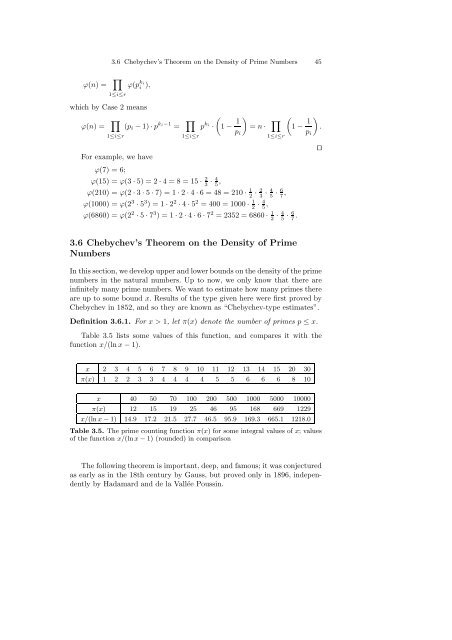Dietzfelbinger M. Primality testing in polynomial time ... - tiera.ru
Dietzfelbinger M. Primality testing in polynomial time ... - tiera.ru
Dietzfelbinger M. Primality testing in polynomial time ... - tiera.ru
Create successful ePaper yourself
Turn your PDF publications into a flip-book with our unique Google optimized e-Paper software.
ϕ(n) = �<br />
3.6 Chebychev’s Theorem on the Density of Prime Numbers 45<br />
1≤i≤r<br />
ϕ(p ki<br />
i ),<br />
which by Case 2 means<br />
ϕ(n) = �<br />
(pi − 1) · p<br />
1≤i≤r<br />
ki−1 = �<br />
p<br />
1≤i≤r<br />
ki �<br />
· 1 − 1<br />
�<br />
= n ·<br />
pi<br />
�<br />
�<br />
1 −<br />
1≤i≤r<br />
1<br />
�<br />
.<br />
pi<br />
⊓⊔<br />
For example, we have<br />
ϕ(7) = 6;<br />
ϕ(15) = ϕ(3 · 5) = 2 · 4=8=15· 2 4<br />
3 · 5 ,<br />
ϕ(210) = ϕ(2 · 3 · 5 · 7) = 1 · 2 · 4 · 6 = 48 = 210 · 1 2 4 6<br />
2 · 3 · 5 · 7 ,<br />
ϕ(1000) = ϕ(23 · 53 )=1· 22 · 4 · 52 = 400 = 1000 · 1 4<br />
2 · 5 ,<br />
ϕ(6860) = ϕ(22 · 5 · 73 )=1· 2 · 4 · 6 · 72 = 2352 = 6860 · 1 4 6<br />
2 · 5 · 7 .<br />
3.6 Chebychev’s Theorem on the Density of Prime<br />
Numbers<br />
In this section, we develop upper and lower bounds on the density of the prime<br />
numbers <strong>in</strong> the natural numbers. Up to now, we only know that there are<br />
<strong>in</strong>f<strong>in</strong>itely many prime numbers. We want to estimate how many primes there<br />
are up to some bound x. Results of the type given here were first proved by<br />
Chebychev <strong>in</strong> 1852, and so they are known as “Chebychev-type estimates”.<br />
Def<strong>in</strong>ition 3.6.1. For x>1, letπ(x) denote the number of primes p ≤ x.<br />
Table 3.5 lists some values of this function, and compares it with the<br />
function x/(ln x − 1).<br />
x 2 3 4 5 6 7 8 9 10 11 12 13 14 15 20 30<br />
π(x) 1 2 2 3 3 4 4 4 4 5 5 6 6 6 8 10<br />
x 40 50 70 100 200 500 1000 5000 10000<br />
π(x) 12 15 19 25 46 95 168 669 1229<br />
x/(ln x − 1) 14.9 17.2 21.5 27.7 46.5 95.9 169.3 665.1 1218.0<br />
Table 3.5. The prime count<strong>in</strong>g function π(x) for some <strong>in</strong>tegral values of x; values<br />
of the function x/(ln x − 1) (rounded) <strong>in</strong> comparison<br />
The follow<strong>in</strong>g theorem is important, deep, and famous; it was conjectured<br />
as early as <strong>in</strong> the 18th century by Gauss, but proved only <strong>in</strong> 1896, <strong>in</strong>dependently<br />
by Hadamard and de la Vallée Pouss<strong>in</strong>.












